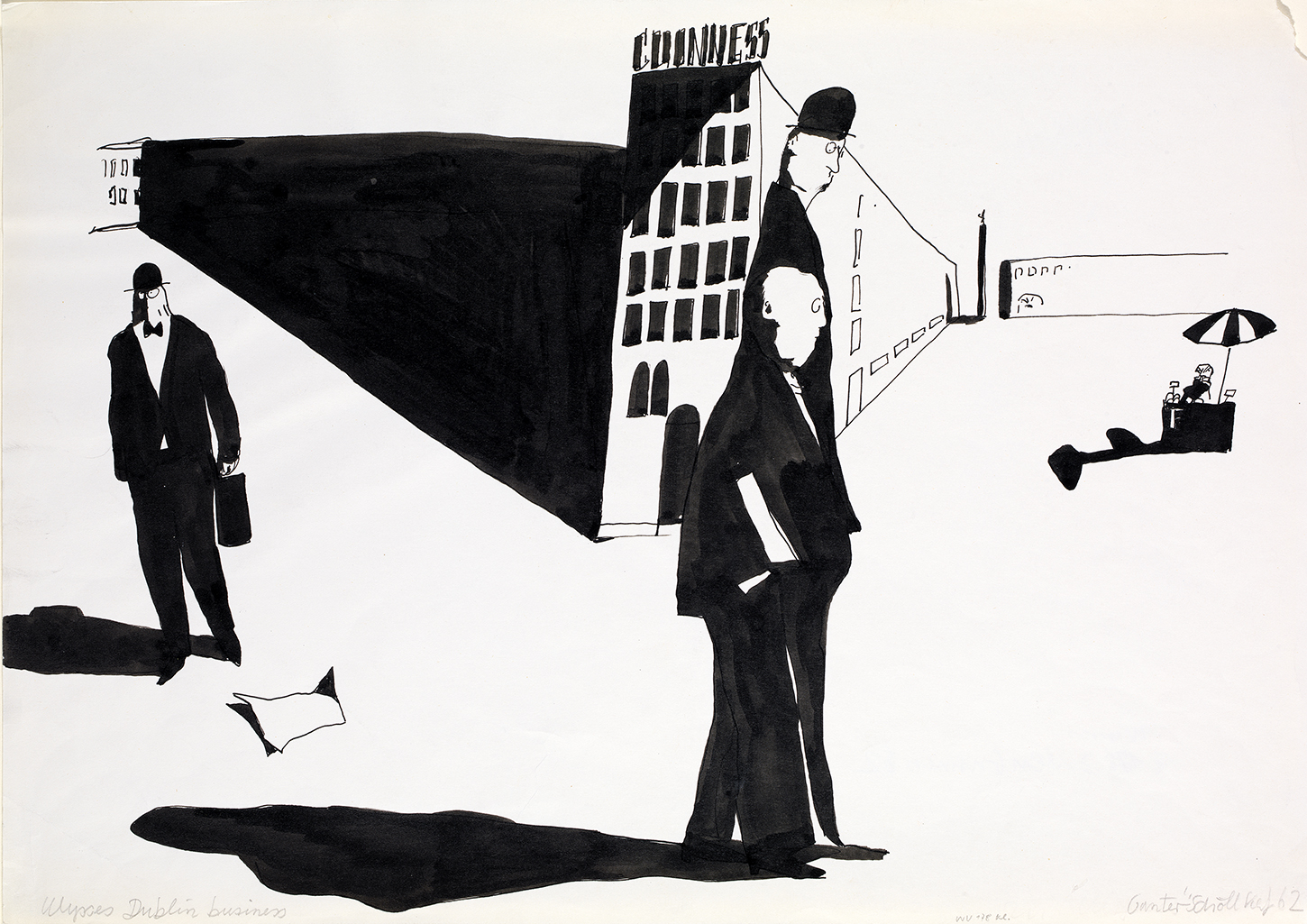 Günter Schöllkopf (1935–1979), Dublin Business, 1962. © The Estate of Günter Schöllkopf. Photo © National Gallery of Ireland.
Günter Schöllkopf (1935–1979), Dublin Business, 1962. © The Estate of Günter Schöllkopf. Photo © National Gallery of Ireland.

To celebrate Bloomsday on Monday 16 June, we’re looking at a few Joycean highlights from our collection. We also have free tours on the day at 1pm and 2.30pm - meet in our Courtyard.
What is Bloomsday?
For anyone unfamiliar with Bloomsday, it celebrates 16 June 1904, the day depicted in James Joyce’s Ulysses, and is named after the novel’s central character Leopold Bloom. The day itself had a special significance for Joyce, as it was the day that he first went out walking together with his future wife, Nora Barnacle! The Gallery's Millennium Wing entrance is located just opposite the site of their initial fateful encounter opposite, outside what was then Finn’s Hotel, where Nora was working as a chamber maid – look up, and you’ll still see the ghost sign for the hotel on gable end of the wall!
 Günter Schöllkopf (1935–1979), Dublin Business, 1962. © The Estate of Günter Schöllkopf. Photo © National Gallery of Ireland.
Günter Schöllkopf (1935–1979), Dublin Business, 1962. © The Estate of Günter Schöllkopf. Photo © National Gallery of Ireland.


Portraits of Joyce in our collection
Joyce himself professed to know little of painting – in a 1906 letter to his brother Stanislaus he writes: “On all subjects – except socialism (for which you care nothing) and painting (of which I know nothing) – we have the same like or opinion”.
Despite this apparent lack of knowledge on painting, he was the subject of quite a number of portraits! The portraits above are just two from the National Portrait Collection here at the National Gallery of Ireland. We also have a portrait of Joyce by photographer Man Ray.
Portrait by Wyndham Lewis
On the right is a 1921 portrait by Wyndham Lewis (1882–1957). A modernist contemporary of Joyce's, Lewis was a writer, painter, and critic, and co-founded the Vorticist movement in art. The year after this portrait was painted, in February 1922, Ulysses was published in Paris by Sylvia Beach’s Shakespeare and Company. The portrait was donated to the Gallery in 1951 by Joyce's friend and patron Harriet Shaw Weaver.
Portrait by Jacques-Emile Blanche
On the left is a portrait of Joyce by Jacques-Emile Blanche (1861-1942) dating from more than a decade later, in 1934, the year of the US publication of Ulysses. Blanche moved in literary circles, and among his other portrait subjects were Marcel Proust (Musée d'Orsay), and Henry James (National Portrait Gallery).


Ulysses landmarks in our collection
Davy Byrne's Pub (above)
It’s in this pub, still located on Duke Street in Dublin, that Leopold Bloom has his lunch of a glass of Burgundy and a gorgonzola sandwich. You can see this landmark very clearly in these two works by Harry Kernoff – the first is a preliminary sketch which shows Kernoff’s detailed annotations about colours. The second is the completed oil painting. Kernoff painted several images of Dublin's so-called 'literary pubs'.
“He entered Davy Byrne's. Moral pub. He doesn't chat. Stands a drink now and then. But in leapyear once in four. Cashed a cheque for me once […] Mr Bloom ate his strips of sandwich, fresh clean bread, with relish of disgust, pungent mustard, the feety savour of green cheese. Sips of his wine soothed his palate. Not logwood that. Tastes fuller this weather with the chill off.
Nice quiet bar. Nice piece of wood in that counter. Nicely planed. Like the way it curves there."

![Flora Mitchell's inscription on her drawing which reads 7 Eccles St, James Joyce [indecipherable] of "Bloomsday"](/sites/default/files/styles/image_block/public/FLora-Mitchell-eccles-writing.jpg?h=75a51e2e&itok=QaGU5ZMI&cache-buster=32ce6c779f&coords_hash=c0e29a5b64)
7 Eccles Street (above)
This work on paper (above left, with detail of the artist's annotation on the right) by Flora Mitchell shows the location of Leopold and Molly Bloom’s house on Eccles Street, where Leopold sets out from on the morning of June 16, and where Molly’s famous closing lines “and yes I said yes I will Yes” were spoken. Interestingly, although 7 Eccles Street was demolished to make way for an extension to the nearby Mater Hospital, the original front door was saved, and you can see it at the James Joyce Centre on North Great George's Street.
Another work by Flora Mitchell with a Joycean link is the depiction of the house on Usher's Island (below) which features in Joyce's short story The Dead.
Happy Bloomsday!
Günter Schöllkopf
German artist Günter Schöllkopf (1935-1979) held a lifelong fascination with Joyce. A collection of 34 of his striking drawings and etchings were presented to the Gallery by his sister in 2019. Dating from the 1960s and 70s, they bring to life characters and episodes from the modernist novel, offering a new context in which to see Molly and Leopold Bloom, Stephen Dedalus and Buck Mulligan.
This animation of Schöllkopf's artworks (below) was commissioned by the Gallery from artist Leanne Dooley on the occasion of our 2022 exhibition, Celebrating Ulysses.
You might also like:
-

Dublin: James Joyce and Erich Hartmann
Photographer Erich Hartmann was inspired by James Joyce's Ulysses
-

Literary and mythological characters
Discover artworks populated with characters from writing
-

Sunday Evening, Place du Combat, Paris (1937) by Harry Kernoff
A keen observation of Paris Café life
-

Celebrating Ulysses
21 May – 21 August 2022

 Flora H. Mitchell (1890-1973), No. 15 Usher's Island (detail), c.1950s. Photo © National Gallery of Ireland.
Flora H. Mitchell (1890-1973), No. 15 Usher's Island (detail), c.1950s. Photo © National Gallery of Ireland.